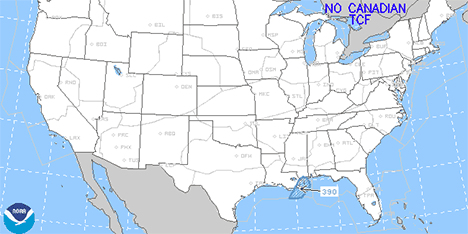
Feb. 16, 2017
The National Weather Service is implementing a new convective weather product – the Traffic Flow Management Convective Forecast (TCF) – which will allow for a more accurate representation of forecasted convective weather. The TCF will have a look and feel that is similar to the CDM Convective Forecast Product (CCFP), which it is replacing.
This new product will provide operators with more accurate and timely forecasts,” said John Kosak, NBAA Air Traffic Services specialist and staff liaison for the NBAA Weather Subcommittee. “Because this is a return to a human-in-the-loop convective product, the users will collaborate on the final product, which will allow a more accurate representation of the forecast convective weather.”
With the new TCF, meteorologists will be able to determine the accuracy of that forecast and add any areas to the final product as high confidence if necessary. Additionally, they can trim areas of excess high confidence.

“With the meteorologist in the loop, we once again have the capability of drawing lines, in addition to the sparse and medium levels of coverage depicting the areas of thunderstorms,” Kosak said. “This is another big change from the automated CCFP that showed only an area of medium coverage, which was basically anything over 40 percent coverage. It would be up to the user to guess if or where lines might form within that area.
“Medium will now only reflect coverages of between 40 and 70 percent,” he added. “Broken lines will also represent 40-70 percent, while solid lines will cover the 74-100 percent range. This should help depict the differences between popcorn thunderstorms, which are more difficult to predict and may require more extensive initiatives, versus frontal thunderstorms that might allow more focused initiatives.”
The FAA’s Collaborative Decision Making Weather Evaluation Team (WET) has been working on a better convective forecast product, with the intent of increasing collaborative participation by users, added Kosak.
The team first working on automating the CCFP, which freed up forecasters to work on the new Collaborative Aviation Weather Statement (CAWS). The idea was that the CAWS would allow collaboration at any time, beyond the limited scope of the automated CCFP. Unfortunately, in 2015 and 1016, when CAWS was used, it was determined that it was “neither effective or ineffective in supporting strategic planning and traffic flow management decision making during convective weather,” Kosak said.
Going forward the WET decided to return to a scheduled product in response to a criticism of the CAWS that required the users to monitor the chat rooms for potential issues 24 hours a day. By returning to a scheduled product, users are able to staff for the specific collaboration times and air traffic managers are guaranteed a product at specific times of the day to use in planning initiatives.
The TCF will initially be a collaborative product from March through October, with plans to eventually collaborate throughout the entire year.


 International Business Aviation Council Ltd.
International Business Aviation Council Ltd.